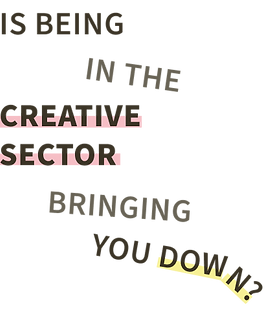





Real Challenges



DISCOVER BACKGROUND | To understand artists.
Industry Context



32%
of Creative Industry employment is Self-employment (DCMS 2021)

.png)
In 2019, 95% of creative companies were micro-businesses (fewer than 10 employees) (DCMS 2022)

The creative industries have been the harbinger of change in the economy. The UK’s Creative Industries are world-leading and are an “engine of the economic growth”
Self-employment and micro-enterprises constitute a significant proportion of the creative industries, making emerging artists more financially vulnerable due to unsteady income compared to those in other sectors.
Personas derived from Real Talks
“What is your day like as an artist?”
“What is your life like as an artist?”
“How do you define yourself as an artist?”
“ What is the most challenging aspect of being an artist?”
「 We spoke with 10 artists, to get to know them, understand their experiences, and uncover the common challenges they all face. 」

Target User
「 So, what do they have in common? 」
In London, those who are self-employed or freelance; financially fragile due to the lack of steady income and no guarantee of working rights.
DEFINE | What’s the problem that we are able to solve?
Problem Statement
「 Can finance-related problems really be solved by design? 」
.png)

Struggling Finacially
How Might We?
HMW help artists to have basic working rights as freelancers/self-employed persons by insuring them and changing their relationship with clients?
HMW help artists to have a steadier income as freelancers/self-employed persons by offering more opportunities to earn money?
DEVELOP | So, how might we strategically engage stakeholders to address the problems?

INTERNAL
「 For the artisits, we want to help them by doing...」
External
「 For our stakeholders, these are our value exchanges 」
DELIVER | It’s time to put our solutions into action and test them.
Hypotheses
「 If we do these, can we change... ? 」
If we provide artists with basic working rights as other employees, then they can have higher tolerance of emergencies at their early career stage.
If we, provided multiple events for artists to be exposed to the public, then artists would gain exposure and a higher chance to collaborate with other creatives to expand their network.
If we provide more opportunities for artists to networking and socialising in the art industry, then they can probably sell their work or get new working opportunities to earn money.
Things to Test
.png)
Will the emerging visual artists be interested in this service?
.png)
What kind of partners/buyers would be more interested in our service to collaborate with?
.png)
Is online or offline the best way to present partners/buyers our artists’ work?
.png)
Is online or offline the best way to present partners/buyers our artists’ work?
Validation
「 To immerse target users and stakeholders in various scenarios of our service, and gather their feedback for further refinement. 」
MONOPOLY GAME
| FOR EMERGING VISUAL ARTISTS
Players would choose to be a freelance artist without agency support or being represented by our agency, Artchute.
As they navigate the board game, they face various career challenges.

PITCH
| FOR PARTNER
We developed a presentation pitch intended for real galleries and hospitality owners, though we did not receive a response.

Vision
A creative support agency
-
Robust contractual security
-
Clearly categorised industrial information
-
Increased opportunities for diverse collaborations
Stragety
Addressing the pain points of emerging visual artists, to improve the art market to be more vibrant and healthier not only for artists to work, but also for clients to deal.
Prototype
Future Scope
Retrospective
「 What do I think is the impact of this project? 」
When discussing impact, particularly issues deeply rooted in the industry and intertwined with financial aspects, what can our project truly achieve?
I believe the answer is transformation. In this project, we use design as a catalyst for change. In the short term, design addresses the smaller, tangible issues within our reach. In the long term, it raises awareness of broader related challenges. This approach sparks discussions, reflections, and new ideas, gradually shifting industry norms and cultural perceptions.
We examine the culture of the art industry by studying how artists are paid, how they communicate, and what their needs are. Through the design embedded in our project, we are reshaping the culture of the creative industry, offering a flexible pathway for freelancers to enter and thrive.
This project originated from our understanding as art school students and the real issues faced by our artist friends.
With limited time and resources, we have done our best to address what we could in a real-world setting.
ARTCHUTE is not yet a fully mature project, but it is born out of genuine need. Our team members have come together after graduation, hoping to further develop this project.
We look forward to seeing where it takes us.
Special Thanks
Firstly, our deepest gratitude goes to our project mentor, Nicolás Rebolledo, whose guidance helped us view and approach the project from fresh perspectives, making us not only more efficient but also more attuned to the art of storytelling. We are equally grateful to David Eveleigh-Evans, our Service Design tutor, for sharing invaluable insights from his professional experience on artists’ career development.
A heartfelt thanks to all the artists who took part in interviews, co-creation sessions, and testing throughout the project. Your involvement provided essential support for our work. Lastly, to my teammates, Tiffany Abraham and Yanwen Yan—thank you for the understanding, support, and encouragement we shared. Together, we created this work, and the story is far from over.
















